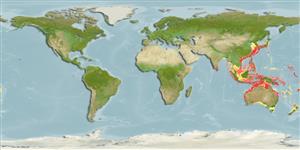Common names from other countries
Environment: milieu / climate zone / depth range / distribution range
экология
морской демерсальный; пределы глубины 20 - 200 m (Ref. 54393), usually 74 - 78 m (Ref. 54393). Tropical
Indo-West Pacific: disjunct distribution: Japan to coast of Aomori Prefecture, Honshu, the Izu Peninsula, Kochi Pref., Ogasawara Islands and southeastern Taiwan; in the south from the Arafura Sea, the NW shelf and Kimberly region of Western Australia; from Geographe Bay northwards.
Size / Вес / Возраст
Maturity: Lm ? range ? - ? cm
Max length : 55.0 cm TL самец/пол неопределен; (Ref. 48636)
Краткое описание
определительные ключи | морфология | морфометрия
колючие лучи спинного плавника (общее число) : 8; членистые (мягкие) лучи спинного плавника (общее число) : 9; колючие лучи анального плавника: 1; членистые (мягкие) лучи анального плавника: 7. This species is distinguished by the following characters: pectoral rays 15-16 (rarely 15); gill rakers 6-7 + 19-22 = 26-28; greatest body depth at or slightly anterior to origin of dorsal fin, 2.9-3.25 in SL; head length (HL) 2.8-3.1 in SL; snout length 1.65-1.9 in HL; cheek depth (lower edge of eye vertically to ventral margin of preopercle) 6.5-9.6 in SL; barbels 1.35-1.45 in HL; the longest dorsal spine 1.5-1.75 in HL; pectoral-fin length 1.25-1.4 in HL, 3.55-4.2 in SL; pelvic-fin length 1.4-1.65 in HL. Colour pale reddish to bluish gray, scale edges red, a yellow stripe from eye to base of caudal fin just above lateral line (stripe may be red in fish from deep water); barbels white to pale yellow (Ref. 54393).
Apparently occurs in deeper waters in the warmer seas of lower latitudes (Ref. 54393). Inhabits silt or mud bottoms near reefs (Ref. 90102).Done
Life cycle and mating behavior
Maturities | размножение | Spawnings | Egg(s) | Fecundities | личинки
Randall, J.E., 2004. Revision of the goatfish genus Parupeneus (Perciformes: Mullidae), with descriptions of two new species. Indo-Pac. Fish. (36):64 p. (Ref. 54393)
Статус Красного Списка МСОП (Ref. 130435)
CITES (Ref. 128078)
Not Evaluated
Угроза для людей
Harmless
Использование человеком
дополнительная информация
инструменты
Специальные отчеты
Скачать в формате XML
ресурсы в Интернет
Estimates based on models
Preferred temperature (Ref.
115969): 18.6 - 27.4, mean 25.9 (based on 42 cells).
Phylogenetic diversity index (Ref.
82804): PD
50 = 0.5000 [Uniqueness, from 0.5 = low to 2.0 = high].
Bayesian length-weight: a=0.01380 (0.00775 - 0.02460), b=3.08 (2.93 - 3.23), in cm Total Length, based on LWR estimates for this species & Genus-body shape (Ref.
93245).
Trophic level (Ref.
69278): 3.5 ±0.37 se; based on food items.
устойчивость к внешним воздействиям (Ref.
120179): средний (среднего размера), минимальное время удвоения популяции 1.4-4.4 года (Preliminary K or Fecundity.).
Fishing Vulnerability (Ref.
59153): Moderate vulnerability (36 of 100).
